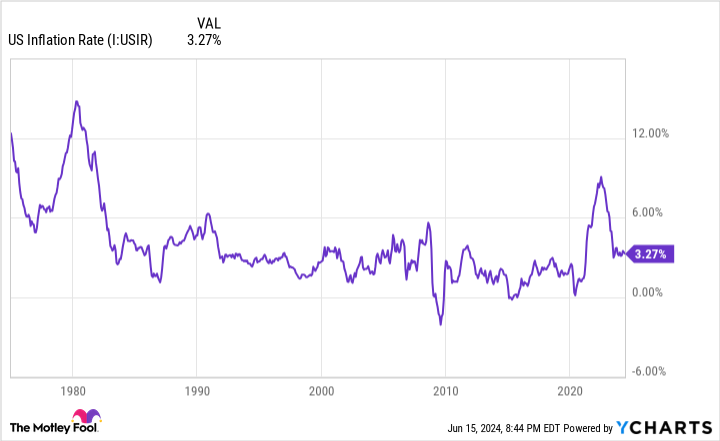In May, 51 million retiree beneficiaries took home an average Social Security check totaling $1,916.63, up $23,000 on an annualized basis. While that may not sound like a game-changing sum of money, the average retiree would struggle mightily without their guaranteed monthly benefit.
For the past 23 years, the national Gallup poll has surveyed retirees to assess their reliance on Social Security income. Between 80% and 90% of respondents consistently relied on their pay as a “major” or “minor” source of income. In other words, most retired workers might not be able to cover their expenses if Social Security didn’t exist.
Considering how important this program has been for more than eight decades to the financial well-being of our nation’s aging workforce, it’s no surprise that the annual cost-of-living adjustment (COLA) is the most anticipated announcement for beneficiaries.


What exactly is the Social Security COLA and how is it calculated?
Simply put, Social Security’s COLA is the mechanism that accounts for inflation. If you were to put together a basket of all the goods and services that older people regularly buy, and the price to buy these collective goods and services increases, the benefits should ideally increase by a proportional amount to ensure that power is not lost. buyer. COLA is the tool that determines how much benefits should increase from one year to the next.
In the 35 years after the first benefit was mailed to Social Security retirees in January 1940, cost-of-living adjustments were disbursed on an arbitrary basis by special sessions of Congress. Not a single COLA occurred in the entire 1940s, and only 11 total adjustments were made before 1975.
Beginning in 1975, the Consumer Price Index for Urban Wage and Clerical Workers (CPI-W) became the annual measure of inflation for America’s main pension program. Each major expenditure category and subcategory within the CPI-W has its own weighting, which allows the index to be reduced to a single digit each month. This makes it really easy to determine whether prices are rising (inflation) or falling (deflation).
Although the CPI-W is reported on a monthly basis by the US Bureau of Labor Statistics (BLS), trailing 12-month CPI-W readings from the third quarter (July-September) are the only figures used to calculate the Social Security COLA for next year.
If the average CPI reading for the third quarter (Q3) of the current year is higher than the average CPI-W reading from the same period last year, inflation has occurred and beneficiaries are about to get a check later. of Social Security. The percentage difference between these average third-quarter CPI-W readings, rounded to the nearest tenth of a percent, determines how much benefits will increase in the coming year.


Social Security’s cost-of-living adjustment hasn’t done this since the late 20th century
For the 51 million retiree beneficiaries who currently receive a monthly take home check, the 2025 Social Security COLA could be extra special. While it’s not currently on track for impressive year-over-year growth, it’s still on pace to do something that was last seen in 1997.
On June 12, the BLS released the long-awaited May inflation report, which showed that the CPI-W had increased by 3.3% on a 12-month basis (TTM). This is one-tenth of a percentage point below the TTM increase in the April inflation report.
Based on this new round of inflation data, Social Security policy analysts at The Senior Citizens League (TSCL), a nonpartisan senior advocacy group, are projecting a COLA of 2.57% for 2025 (to be rounded to 2.6%), which is down from a previous forecast of 2.66% following the release of the April inflation report. Over the past 20 years, the average cost of living adjustment has been 2.6%.
However, even average COLAs have been difficult to achieve on a consistent basis since the turn of this century. Deflation resulted in no COLAs in 2010, 2011 and 2016, while the 2017 COLA was the smallest on record (just 0.3%). In total, there have been 11 years with a COLA of 2% or less since 2000.
But over the past three years, beneficiaries have enjoyed a hearty boost in their Social Security checks. Cost of living adjustments totaling 5.9%, 8.7%, and 3.2% were enacted in 2022, 2023, and 2024, respectively. The 8.7% COLA in 2023 was the highest in 41 years.
If TSCL’s forecast proves correct and Social Security recipients receive an estimated 2.6% cost-of-living adjustment in 2025, it will mark the first time since 1997 that there have been four consecutive years of COLAs reaching at least 2.6 % (each COLA between 1988 and 1997 ranged between 2.6% and 5.4%).
What does a 2.6% COLA mean in dollar terms? For the average retired worker, their monthly check will increase by approximately $50. Meanwhile, the average disabled worker and the average survivor can expect their monthly wages to increase by $40 and $39, respectively.


Bigger COLAs just aren’t cutting it for retirees
While the first four-year chunk of COLAs that reaches at least 2.6% at age 28 is likely to be enjoyed by those who receive a Social Security check, the fact remains that seniors continue to get the short end of the stick when looked at over time. many decades.
In May 2023, TSCL published a study that compared overall Social Security COLAs between January 2000 and February 2023 with price differences on a basket of goods and services regularly purchased by seniors. While the aggregate COLA had increased by 78% since the beginning of the 21st century, the basket of commonly purchased goods and services had collectively increased in price by 141.4% since January 2000.
Put another way, the purchasing power of a Social Security dollar has decreased by 36% since the beginning of this century. Although COLAs have been slightly higher in recent years, they are often still out of step with the actual inflation that seniors are facing.
The culprit behind this continued loss of purchasing power is the CPI-W. As its full names suggest, it tracks the spending habits of “urban wage earners and clerical workers.” These are mostly working-age Americans who don’t currently receive a Social Security benefit. More importantly, they spend their money differently than the 86% of Social Security recipients who are 62 and older.
For example, seniors spend a higher percentage of their monthly budget on housing and health care costs than the average American. Based on TTM, housing and medical care inflation stood at 5.4% and 3.1%, respectively, as of May 2024, for the Consumer Price Index for All Urban Consumers (CPI-U).
Housing inflation has remained stubbornly high due to the Federal Reserve’s tight monetary policy and rapidly rising mortgage rates. Meanwhile, inflation of medical care services has increased over the past seven months. The purchasing power of Social Security income continues to decline over time because the CPI-W does not properly weigh the costs that matter most to seniors.
I’m sorry to say that a projected 2.6% cost of living adjustment in 2025 is unlikely to change this dynamic.
$22,924 Most retirees completely overlook the Social Security bonus
If you’re like most Americans, you’re a few years (or more) behind on your retirement savings. But a handful of little-known “Social Security secrets” can help ensure your retirement income grows. For example: a simple scam can pay you up to dollars22,924 more… every year! Once you learn how to maximize your Social Security benefits, we think you can confidently retire with the peace of mind we all seek. Just click here to find out how to learn more about these strategies.
Watch “Secrets of Social Security” ›
The Motley Fool has a disclosure policy.
Social Security’s 2025 cost-of-living adjustment (COLA) is on track to do something that hasn’t happened in 28 years was originally published by The Motley Fool